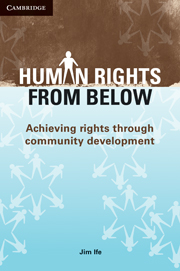Book contents
- Frontmatter
- Contents
- Acknowledgements
- Introduction
- Part 1 Thinking about community development
- Part 2 Thinking about human rights
- Part 3 Bringing human rights and community development together
- Part 4 Enacting human rights from below
- 6 Seven arenas of human rights from below
- 7 Practising human rights from below
- Appendix: The human rights matrix
- References
- Index
6 - Seven arenas of human rights from below
Published online by Cambridge University Press: 05 June 2012
- Frontmatter
- Contents
- Acknowledgements
- Introduction
- Part 1 Thinking about community development
- Part 2 Thinking about human rights
- Part 3 Bringing human rights and community development together
- Part 4 Enacting human rights from below
- 6 Seven arenas of human rights from below
- 7 Practising human rights from below
- Appendix: The human rights matrix
- References
- Index
Summary
It will be recalled that in previous chapters seven dimensions of community development and of human rights were identified: social, economic, political, cultural, environmental, spiritual and survival. When we discuss these seven in relation to enacting human rights from below, we must remember that a holistic approach to human rights from below implies that all seven are important: none should necessarily have primacy over the others in a general sense, though in any particular community setting one or two may be seen as more important in responding to local circumstances.
While different human rights workers will have strengths in different areas, and will choose to concentrate on perhaps one or two areas in particular, they should never lose sight of a more overall, holistic view of human rights from below. Just as all seven are necessary for effective community development, so all seven are necessary for human rights from below, as without all seven some important aspects of humanity, and of community, will be missed.
SOCIAL RIGHTS AND SOCIAL DEVELOPMENT
Social rights are particularly appropriate for a perspective of human rights from below. Our social rights to things such as education, housing, health care (though this can also be included under ‘survival rights’), recreation, choice of marriage partner and family lifestyle, work and meaningful relationships cannot readily be articulated in a universalist, context-free sense. What these social rights mean, and how they are defined and enacted, will vary significantly according to context.
- Type
- Chapter
- Information
- Human Rights from BelowAchieving Rights through Community Development, pp. 157 - 199Publisher: Cambridge University PressPrint publication year: 2009



